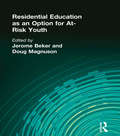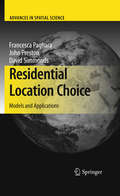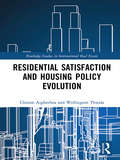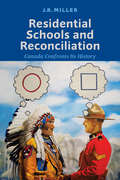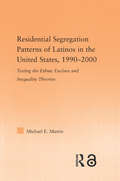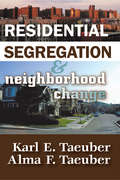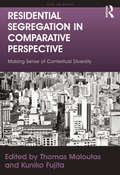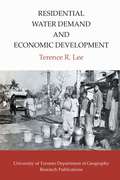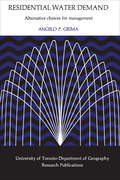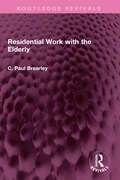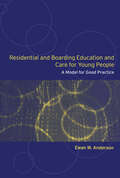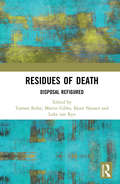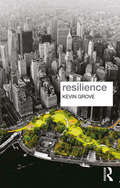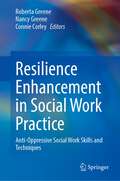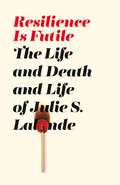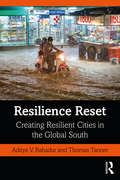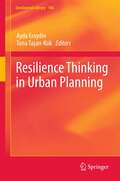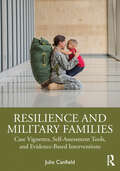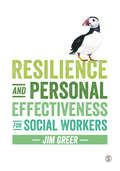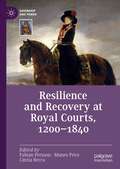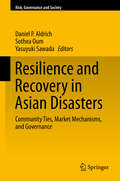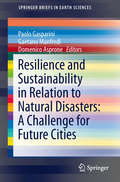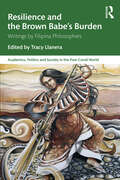- Table View
- List View
Residential Education as an Option for At-Risk Youth
by Jerome Beker Doug MagnusonResidential Education as an Option for At-Risk Youth explores recent residential programs in Israel, draws comparisons with their European counterparts, and recommends practical approaches for the revitalization of such programs in the United States. This volume refutes the conventional professional “wisdom” in the United States that residential group care programs for children and youth are intrinsically flawed and counterproductive. Instead, it delivers effective models for the implementation of effective residential services. The editors and authors demonstrate the growing need for residential programs, given the overburdened family foster care resources, swelling numbers of “zero-parent” families, and homeless youth. Though the United States helped launch and develop residential services in Europe in the aftermath of World War II and has produced many excellent thinkers in the domain of quality residential group care, American programs have languished in recent decades. This book is designed to accelerate and facilitate progress in revamping and establishing excellent residential group care. The authors examine residential education as a developmentally based alternative to the more clinically and correctionally oriented programs for marginal children and youth dominating this field in the United States.The authors present their material in the context of appropriate theoretical principles, yet in practical ways that will permit program developers and managers to implement it effectively. Some of the specific areas chapters discuss are: exemplary Israeli programs as observed by visiting American professional in social work and allied fields important program variables and the cultural influences that may affect them African American experience for such programs a conceptual model for building successful residential education programs key organizational and management considerationsResidential Education as an Option for At-Risk Youth serves as a vital resource for ambitious program developers and managers wishing to reconceptualize and enrich their programs. It will also benefit advanced students, practitioners, and decision makers who have had, heretofore, few resources to rely on when seeking to promote more effective programs for socially marginal children and youth.
Residential Location Choice: Models and Applications
by John Preston David Simmonds Francesca PagliaraThe effective planning of residential location choices is one of the great challenges of contemporary societies and requires forecasting capabilities and the consideration of complex interdependencies which can only be handled by complex computer models. This book presents a range of approaches used to model residential locations within the context of developing land-use and transport models. These approaches illustrate the range of choices that modellers have to make in order to represent residential choice behaviour. The models presented in this book represent the state-of-the-art and are valuable both as key building blocks for general urban models, and as representative examples of complexity science.
Residential Satisfaction and Housing Policy Evolution (Routledge Studies in International Real Estate)
by Clinton Aigbavboa Wellington ThwalaThis book explores residential satisfaction and housing policy trends in developing nations by using subsidised low-income housing examples in South Africa, Ghana and Nigeria as case studies. While there has been much documentation on the formation of residential satisfaction and the evolution of housing policy in developed nations, relatively little has been written about these topics in developing nations. This book provides readers with two major practical insights: The first is focused on the theoretical underpinning of residential satisfaction and the formation of residential satisfaction in subsidised low-income housing through the development of a conceptual framework, while the second is focused on housing policy evolution and its trends in South Africa. In this section of the book, comparative overviews of public housing in two West African countries are provided with an emphasis on the philosophical basis for its development in these countries. The central aim of the book is to provide readers with ideas on residential satisfaction formation and housing policy trends in South Africa.
Residential Schools and Reconciliation: Canada Confronts Its History
by J. R. MillerSince the 1980s successive Canadian institutions, including the federal government and Christian churches, have attempted to grapple with the malignant legacy of residential schooling, including official apologies, the Royal Commission on Aboriginal Peoples, the Indian Residential Schools Settlement Agreement, and the Truth and Reconciliation Commission (TRC). In Residential Schools and Reconciliation, award winning author J. R. Miller tackles and explains these institutional responses to Canada’s residential school legacy. Analysing archival material and interviews with former students, politicians, bureaucrats, church officials, and the Chief Commissioner of the TRC, Miller reveals a major obstacle to achieving reconciliation – the inability of Canadians at large to overcome their flawed, overly positive understanding of their country’s history. This unique, timely, and provocative work asks Canadians to accept that the root of the problem was Canadians like them in the past who acquiesced to aggressively assimilative policies.
Residential Segregation Patterns of Latinos in the United States, 1990-2000: Testing The Ethnic Enclave And Inequality Theories (Latino Communities: Emerging Voices - Political, Social, Cultural and Legal Issues)
by Michael E MartinHistorically, residential segregation of Latinos has generally been seen as a result of immigration and the process of self-segregation into ethnic enclaves. The only theoretical exception to ethnic enclave Latino segregation has been the structural inequality related to Latinos that have a high degree of African ancestry. This study of the 331 metropolitan area in the United States between 1990 and 2000 shows that Latinos are facing structural inequalities outside of the degree of African ancestry. The results of the author's research suggest that Latino segregation is due to the mobility of Latinos and structural barriers in wealth creation due to limited housing equity and limited occupational mobility. In addition, Latino suburbanization appears to be a segregation force rather than an integration force. This study also shows that Mexicans, Puerto Ricans and Cubans have different experiences with residential segregation. Residential segregation of Cubans does not appear to be a problem in the U.S. Puerto Ricans continue to be the most segregated Latino sub-group and inequality is a large factor in Puerto Rican segregation. A more in-depth analysis reveals that the Puerto Rican experience is bifurcated between the older highly segregated enclaves where inequality is a large problem and new enclaves where inequality and segregation are not an issue. The Mexican residential segregation experience reflects that immigration and mobility are important factors but previous theorists have underestimated the barriers Mexicans face in obtaining generational wealth and moving from the ethnic enclave into the American mainstream.
Residential Segregation and Neighborhood Change
by Karl E. Taeuber Alma F. TaeuberThis book is an invaluable reference. First published in 1965, it is at once a snapshot of a moment in history and a timeless conceptualization of the issues inherent in societal segregation.Residential segregation historically occupies a key position in patterns of race relations in the urban United States. It not only inhibits the development of informal, neighborly relations between white people and African Americans, but ensures the segregation of a variety of public and private facilities. The clientele of schools, hospitals, libraries, parks, and stores is determined in large part by the racial composition of the neighborhood in which they are located. Problems created by residential segregation are the focus of this of this work.African Americans in cities resemble whites in cities. Both racial groups are highly urbanized, and most of the immigrants of either race to a city are former residents of another city. Within cities, racial groups display similar patterns of residential behavior, with those of higher incomes seeking out newer and better housing. Both races respond similarly to national, social, and economic factors which set the context within which local changes occur. Karl E. and Alma F. Taeuber's main approach to the analysis of residential segregation and processes of neighborhood change is comparative and statistical. By quantitative comparison of the situation in many different cities, they attempt to assess those patterns and processes which are common to all communities and those which vary.Residential segregation is shown to be a prominent and enduring feature of American urban society. By bringing empirical data to bear on an important and timely social problem, this book will aid in the search for reasonable solutions. All types of cities, southern and northern, large and small, are beset with the difficulties that residential segregation imposes on harmonious race relations and on the solution of pressing city prob
Residential Segregation in Comparative Perspective: Making Sense of Contextual Diversity (Cities and Society)
by Kuniko FujitaWe know very little about variations in urban class and ethnic segregation among nations and even less about differences among cities in different regions of the world. Spatial organization (places and neighbourhoods) matters significantly in some cities in reproducing class relations and ethno-racial hierarchies, but may be much less important in others. The degree and the impact of segregation depend upon contextual diversity. By emphasizing the importance of contextual diversity in the study of urban residential segregation, the book questions currently popular urban theories such as global city, neoliberal urbanism, and gentrification. These theories tend to dissociate cities from their national and regional context and thus ignore their history, culture, politics and institutions. The aim of this book is to introduce the significantly different urban experiences in social and spatial segregation patterns and rationales which exist among the world's regions and to demonstrate that urban theory needs to draw systematically upon this wide range of experiences. The cities selected (Athens, Beijing, Budapest, Copenhagen, Hong Kong, Madrid, Paris, São Paulo, Taipei, and Tokyo) were chosen in order to achieve geographical spread, to maximise the diversity of types of socioeconomic regulation.This volume is thus able to avoid the interpretative limitations and misconstructions resulting from universalizing the Anglo-American experience.
Residential Water Demand and Economic Development (The Royal Society of Canada Special Publications #2)
by Terence LeeIn the last twenty years the problem of urban public water supples has become increasingly serious. Disparities between the effective supply of, and demand for, water has grown rapidly and now constitute a danger to public health. This study deals with the place of urban public water supplies in economic development and with the demand for such elements of the social infrastructure during the process of economic and social growth. Based on an examination of the existing water-use systems in two urban areas in India, this study provides valuable information in a field that is of growing concern to all the developing countries of the world.
Residential Water Demand: Alternative Choices for Management
by Angelo P. GrimaThis detailed study of the use of water at different price levels by residential consumers in the Toronto-centred region from Hamilton to Oshawa challenges the basis of our present urban water supply policy. Adoption of the recommendations presented would mean higher prices to householders, but a considerable saving of hundreds of millions of tax dollars over the next three decades. The present policy uses a 'requirement approach' in which future water needs are calculated by extrapolation of past trends and an assumption that demand is inelastic. This leads to excessive levels of water use and over-investment in water supply, sewage collection, and treatment systems. The resultant misallocation of resources can be corrected by adoption of a demand/management approach in which investment policy is guided by consumer demand and alternative pricing arrangements are used as a management tool. Dr. Grima examines several alternative choices for management, such as metering, increasing marginal prices, sewerage charges, seasonal charges, and an increasing price block schedule, and describes the results of each. Water managers in Canada are strongly challenged to begin a fundamental rethinking of their basic policies. (Department of Geography Research Publication 7)
Residential Work with the Elderly (Routledge Revivals)
by C Paul BrearleyFirst published in 1977, Residential Work with the Elderly brings together theoretical and practical approaches of relevance to providing care for older people in residential homes and long-stay geriatric hospitals. He describes the kinds of use to which institutional care is commonly put, the effects of institutional living o individual residents and the ageing process. He also examines ways of using such care to the benefit of both individuals and the resident group, so that new, improved ways may be found of helping older people in care. Intended principally for residential workers in homes for the elderly, the book is also designed for nurses and other workers involved in long-term hospital care for older people. It will also be of value to those involved in day-care and special housing provision for the elderly.
Residential and Boarding Education and Care for Young People: A Model for Good Management and Practice
by Ewan AndersonThis innovative book identifies the key elements of good management and practice common to all residential child care settings - whether hospital unit, boarding school, children's home, special school or custodial care establishment - and important variations between the different settings. Using a model developed under the auspices of the Rowntree Foundation, it provides managers with a coherent framework for understanding the different facets of their role and the outcomes they are aiming to achieve. Major components of the model are:· the environment· the legal framework· developmental issues· time-related issues.In each case the salient factors for practice and management are identified and discussed. Good Practice Education and Residential Care of Children offers a model which can be readily applied to training, assessment of standards, inspections, and research and development. Based on the latest research and reflecting the national drive towards evidence-based standards, it will be an invaluable support to managers in training and practice.
Residues of Death: Disposal Refigured
by Tamara Kohn Martin Gibbs Bjorn Nansen Luke Van RynThis book provides a critical overview of the changing ways people mourn, commemorate and interact with the remains of the dead, including bodies, materials and digital artefacts. It focuses on how residues of death persist and circulate through different spaces, materials, data and mediated memories, refiguring how the disposal of the dead is understood, enacted and contested across the globe. The volume contains contributions by scholars from a number of disciplines and includes a diverse range of case studies drawn from Asia, Europe and North America. Together they reveal how rapidly changing practices, industries and experiences around death’s remains involve the entwining of digital technologies with other material and ritualised forms of commemoration, as well as with shifting boundaries between the sacred and the profane, the institutional and the vernacular, the public and the private.
Resilience (Key Ideas In Geography Ser.)
by Kevin GroveIs resilience simply a fad, or is it a new way of thinking about human–environment relations, and the governance of these relations, that has real staying power? Is resilience a dangerous, depoliticizing concept that neuters incipient political activity, or the key to more empowering, emancipatory, and participatory forms of environmental management? Resilience offers an advanced introduction to these debates. It provides students with a detailed review of how the concept emerged from a small corner of ecology to critically challenge conventional environmental management practices, and radicalize how we can think about and manage social and ecological change. But Resilience also situates this new style of thought and management within a particular historical and geographical context. It traces the roots of resilience to the cybernetically-influenced behavioral science of Herbert Simon, the neoliberal political economic theory of new institutional economics, the pragmatist philosophy of John Dewey, and the modernist design aesthetic of the Bauhaus school. These diverse roots are what distinguish resilience approaches from other ways of studying human-environment relations. Resilience thinking recalibrates the study of social and environmental change around a will to design, a drive or desire to synthesize diverse forms of knowledge and develop collaborative, cross-boundary solutions to complex problems. In contrast to the modes of analysis and critique found in geography and cognate disciplines, resilience approaches strive to pragmatically transform human–environment relations in ways that will produce more sustainable futures for complex social and ecological systems. In providing a road map to debates over resilience that brings together research from geography, anthropology, sociology, international relations, and philosophy, this book gives readers the conceptual and theoretical tools necessary to engage with political and ethical questions about how we can and should live together in an increasingly interconnected and unpredictable world.
Resilience Enhancement in Social Work Practice: Anti-Oppressive Social Work Skills and Techniques
by Nancy Greene Roberta Greene Connie CorleyAs people around the globe experience more civil unrest and environmental disruption, the difficulties social workers face in their practice are becoming increasingly complex. This textbook deepens and expands the resilience-enhancing stress model (RESM) skill set and techniques so that social workers can more effectively serve clients and constituencies who are trying to overcome the stress of difficult life transitions and challenging environmental demands. It is designed as a companion piece to A Resilience-Enhancing Stress Model: A Social Work Multisystemic Practice Approach (Springer, 2022). The intent of the RESM is to further expand social workers' practice skill sets with additional concepts from the anti-oppressive practice (AOP) and coaching literature that aligns with the Educational Policy and Accreditation Standards from the Council on Social Work Education (CSWE). The book's 12 chapters are organized around life transitions and illustrate skills, techniques, and interviews important to the enhancement of resilience. Among the topics covered:The Resilience-Enhancing Stress Model: Articulating Anti-Oppressive PracticeExploring the Role of Cultural Diversity in Resilient Social Functioning: Theory and SkillsCountering Human Rights Violations During Life TransitionsFacilitating Community Development Following DisruptionResilience Enhancement in Social Work Practice: Anti-Oppressive Social Work Skills and Techniques uniquely offers practitioners a knowledge base to exponentiate their efficacy in identifying and fortifying resilience in a time in history when it appears to be imperative. It is written for a student social work audience at the generalist or advanced generalist level for practice across a range of populations and settings. It contains traditional and contemporary human behavior content that supports a social work narrative methodology and a life course perspective. It could be taught with its predecessor across one or two semesters. Practitioners in the field who are new to this content could also find the text a valuable resource.
Resilience Is Futile: The Life and Death and Life of Julie S. Lalonde
by Julie S. LalondeFor over a decade, Julie Lalonde, an award-winning advocate for women’s rights, kept a secret. She crisscrossed the country, denouncing violence against women and giving hundreds of media interviews along the way. Her work made national headlines for challenging universities and taking on Canada’s top military brass. Appearing fearless on the surface, Julie met every interview and event with the same fear in her gut: was he there? Fleeing intimate partner violence at age 20, Julie was stalked by her ex-partner for over ten years, rarely mentioning it to friends, let alone addressing it publicly. The contrast between her public career as a brave champion for women with her own private life of violence and fear meant a shaky and exhausting balancing act. Resilience sounds like a positive thing, so why do we often use it against women? Tenacity and bravery might help us survive unimaginable horrors, but where are the spaces for anger and vulnerability? Resilience is Futile is a story of survival, courage and ultimately, hope. But it’s also a challenge to the ways we understand trauma and resilience. It’s the story of one survivor who won’t give up and refuses to shut up.
Resilience Reset: Creating Resilient Cities in the Global South
by Thomas Tanner Aditya V. BahadurDrawing on evidence from urban resilience initiatives around the globe, the authors make a compelling argument for a "resilience reset", a pause and stocktake that critically examines the concepts, practices and challenges of building resilience, particularly in cities of the Global South. In turn, the book calls for the world’s cities to alter their course and "pivot" towards novel approaches to enhancing resilience. The book presents shifts in ways of acquiring and analysing data, building community resilience, approaching urban planning, engaging with informality, delivering financing, and building the skills of those running cities in a post-COVID world grappling with climate impacts. In Resilience Reset, the authors encourage researchers, policymakers, and practitioners to break out of existing modes of thinking and doing that may no longer be relevant for our rapidly urbanising and dynamic world. The book draws on the latest academic and practice-based evidence to provide actionable insights for cities that will enable them to deal with multiple interacting shocks and stresses. The book will be an indispensable resource to those studying urbanisation, development, climate change and risk management as well as for those designing and deploying operational initiatives to enhance urban resilience in businesses, international organisations, civil society organisations and governments. It is a must-read for anyone interested in managing the risks of climate impacts in urban centres in the Global South.
Resilience Thinking in Urban Planning
by Tuna Taşan-Kok Ayda EraydinThere is consensus in literature that urban areas have become increasingly vulnerable to the outcomes of economic restructuring under the neoliberal political economic ideology. The increased frequency and widening diversity of problems offer evidence that the socio-economic and spatial policies, planning and practices introduced under the neoliberal agenda can no longer be sustained. As this shortfall was becoming more evident among urban policymakers, planners, and researchers in different parts of the world, a group of discontent researchers began searching for new approaches to addressing the increasing vulnerabilities of urban systems in the wake of growing socio-economic and ecological problems. This book is the joint effort of those who have long felt that contemporary planning systems and policies are inadequate in preparing cities for the future in an increasingly neoliberalising world. It argues that "resilience thinking" can form the basis of an alternative approach to planning. Drawing upon case studies from five cities in Europe, namely Lisbon, Porto, Istanbul, Stockholm, and Rotterdam, the book makes an exploration of the resilience perspective, raising a number of theoretical debates, and suggesting a new methodological approach based on empirical evidence. This book provides insights for intellectuals exploring alternative perspectives and principles of a new planning approach.
Resilience and Ageing: Creativity, Culture and Community (Connected Communities)
by Anna Goulding, Bruce Davenport and Andrew NewmanUnderstanding how creative interventions can help develop social connectivity and resilience for older people is vital in developing a holistic cross-sector approach towards ageing well. Academics with a wide range of expertise critically reflect on how the built environment, community living, cultural participation, lifelong learning, and artist-led interventions encourage older people to thrive and overcome both challenging life events and the everyday changes associated with ageing. The book uses a range of approaches, including participatory research methods, to bring the voices of older people themselves to the foreground. It looks at how taking part in creative interventions develops different types of social relationships and fosters resilience.
Resilience and Military Families: Case Vignettes, Self-Assessment Tools, and Evidence-Based Interventions
by Julie CanfieldThis textbook aims to educate students across all mental health disciplines on the importance of using strengths-based resilience as a tool when working with military families. Organized into three main sections using the military deployment cycle, including the stages of pre-deployment, deployment, and post-deployment, this textbook examines some of the key resiliency skills that operate in military families so that students can understand how many families not only survive, but learn how to thrive, during great challenges. Chapters address the military at home, resilient family systems, the importance of effective communication and social support, the impact of trauma and moral injury, and the transition from military to civilian life following service. Filled with case vignettes, self-assessment tools, and evidence-informed interventions, readers learn multiple ways to measure, assess, and strengthen family resiliency throughout the book. In addition to these skills, specific examples are highlighted that draw lessons from the military community on stress management and posttraumatic growth in the context of family life. The book finishes with an appendix that includes suggestions for therapists on the use of cultural humility to improve treatment.Following two decades of war and a global pandemic, this essential textbook is a crucial read for all mental health professionals training to work with miliary-connected populations and their families. Professionals from disciplines including clinical social work, marriage and family therapy, psychology, healthcare, and theology as well as instructors of courses on military social work, military psychology, and mental health will all find this text an invaluable resource.
Resilience and Personal Effectiveness for Social Workers
by Jim GreerSocial work in the 21st century is facing great change and upheaval in a period of Government austerity measures. From worsening pay rates to limited resources, these are increasingly challenging times in which social workers practice. It is therefore important that social work students are prepared for the realities of working within the modern social care system - that they have the tools and skills to care for themselves, and not just others. This book is a straightforward guide on how to cope with the stress and pressures of today’s social work environment by developing the right skills and knowledge. It will help students learn from a very early stage how to be at their best; from developing strategies to look after themselves and making the best use of supervision to the support they need to dealing with bullies and/or difficult people - all essential guidance on how to improve their health and mental wellbeing and prepare them to manage the challenges they will face.
Resilience and Personal Effectiveness for Social Workers
by Jim GreerSocial work in the 21st century is facing great change and upheaval in a period of Government austerity measures. From worsening pay rates to limited resources, these are increasingly challenging times in which social workers practice. It is therefore important that social work students are prepared for the realities of working within the modern social care system - that they have the tools and skills to care for themselves, and not just others. This book is a straightforward guide on how to cope with the stress and pressures of today’s social work environment by developing the right skills and knowledge. It will help students learn from a very early stage how to be at their best; from developing strategies to look after themselves and making the best use of supervision to the support they need to dealing with bullies and/or difficult people - all essential guidance on how to improve their health and mental wellbeing and prepare them to manage the challenges they will face.
Resilience and Recovery at Royal Courts, 1200–1840 (Queenship and Power)
by Cinzia Recca Munro Price Fabian PerssonThis book demonstrates the evolution of resilience and recovery as a concept by applying it to a new context, that of courts and monarchies. These were remarkably resilient institutions, with a strength and malleability that allowed them to ‘bounce back’ time and again. This volume highlights the different forms of resilience displayed in European courts during the medieval and early modern periods. Drawing on rarely published sources, it demonstrates different models of monarchical resilience, ranging from the survival of sovereign authority in political crisis, to the royal response to pandemic challenges, to other strategies for resisting internal or external threats. Resilience and Recovery illustrates how symbolic legitimacy and effective power were strongly intertwined, creating a distinct collective memory that shaped the defence of monarchical authority over many centuries.
Resilience and Recovery in Asian Disasters
by Daniel P. Aldrich Sothea Oum Yasuyuki SawadaThis book establishes a new, holistic framework for disaster recovery and mitigation, providing a multidisciplinary perspective on the field of risk management strategies and societal and communal resilience. Going beyond narrow approaches that are all too prevalent in the field, this work builds on an optimum combination of community-level networks, private market mechanisms and state-based assistance strategies. Its chapters describe best practices in the field and elucidate cutting-edge research on recovery, highlighting the interaction between government, industry and civil society. The book uses new data from a number of recent disasters across southeast and east Asia to understand the interactions among residents, the state, and catastrophe, drawing on events in Malaysia, Vietnam, Cambodia, Japan, China and Thailand. Grounded in theories of risk mitigation and empirical research, the book provides practical guidance for decision makers along with future research directions for scholars. The Asian region is highly prone to natural disasters which devastate large and mostly poor populations. This book deals with some of the root issues underlying the continued vulnerability of these societies to catastrophic shocks. The book is unusual in that it comprehensively covers resilience and fragilities from community levels to market mechanisms and governance and it analyses these issues in very different economic and structural settings. Recommended for development and disaster risk managers--without question. Professor Debarati Guha-Sapir Director, Centre for Research on the Epidemiology of Disasters (CRED); Professor, University of Louvain, Research Institute Health and Society.
Resilience and Sustainability in Relation to Natural Disasters: A Challenge for Future Cities
by Paolo Gasparini Gaetano Manfredi Domenico AsproneThe number of megacities worldwide is rapidly increasing and contemporary cities are also expanding fast. As a result, cities and their inhabitants are becoming increasingly vulnerable to the effects of catastrophic natural events such as extreme weather events (recently more frequent and intense as a result of the ongoing climate changes), earthquakes, tsunamis or man-induced events such as terrorist attacks or accidents. Furthermore, due to increasing technological complexity of urban areas, along with increasing population density, cities are becoming more and more risk attractors. The resilience of cities against catastrophic events is a major challenge of today. It requires city transformation processes to be rethought, to mitigate the effects of extreme events on the vital functions of cities and communities. Redundancy and robustness of the components of the urban fabric are essential to restore the full efficiency of the city's vital functions after an extreme event has taken place. These items were addressed by an interdisciplinary and international selection of scientists during the 6th UN-World Urban Forum that was held in Naples, Italy in September 2012. This volume represents in six chapters the views from sociologists, economists and scientists working on natural risk and physical vulnerability on resilience and sustainability for future cities in relation to natural disasters.
Resilience and the Brown Babe’s Burden: Writings by Filipina Philosophers (Academics, Politics and Society in the Post-Covid World)
by Tracy LlaneraThis volume examines the concept and practice of resilience from the perspective of Filipina philosophers. It investigates the double-edged nature of resilience and other key assumptions and ideas about human resilience and resilient cultures and institutions. The chapters in the collection are intersectional in approach, drawing from feminist theory, social and political philosophy, critical theory, pragmatism, virtue theory, social epistemology, and decolonial theory in their engagement of the theme. Part of the Academics, Politics and Society in the Post-Covid World series, the book will be of interest to scholars and students of philosophy, political theory, feminist theory, philosophy of education, cultural studies, and development studies. It will be valuable to academics in Philippine Studies, Asian and Southeast Asian Studies, and Global South Studies.
